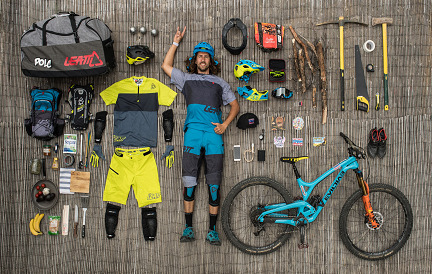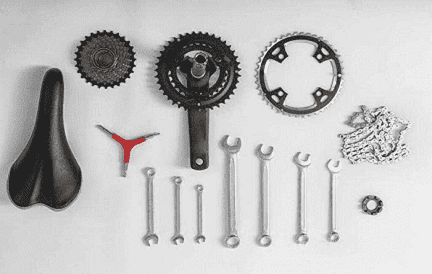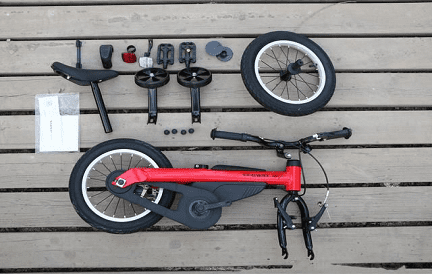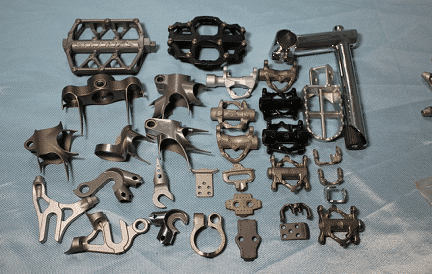Lightweight, stiff, and providing brilliant vibration absorption, the carbon Mtb fork is, despite appearances, no longer a novelty in the world of bicycles, with the first serious frames being built just three decades ago!
- Part 1: Overall Evaluation: Pros And Cons
- Part 2: Carbon Mtb Fork Introduction
- Part 3: Details of the Main Parameters
- Part 4: Main Purpose of the Carbon Mtb Fork
- Part 5: Details
- Part 6: Carbon Mtb Fork Specification Sheet
Part 1: Overall Evaluation: Pros And Cons
Carbon Mtb Fork: Advantages
Let’s start with the most obvious one, i.e. weight. it is lighter than aluminum, and even more definitely than steel. Thanks to carbon fiber you can save a few hundred grams, and if you add to this the effect of using fiber in other components, we get a very satisfactory result.
What else can we gain by choosing a carbon mountain bike fork? Most riders associate professionalism with comfort. Carbon dampens vibrations very well. Even steel is better than aluminum in this respect. Not everyone will immediately feel the difference, and, unlike mass, this cannot be expressed in simple units such as grams. One of the more often described advantages is also designed. Carbon forks are more aerodynamic.
Carbon Mtb fork is touted as being ideal for mountainous terrain, but this is a very personal opinion, as some still prefer steel since it was more widely used in the 1980s, so, usually, there will be those who prefer metal, especially in this era of steel fork renaissance. Such tubes can be found in both the cheapest and costly ones, artfully decorated and considered unique.
Carbon Mtb Fork: Disadvantages
The tubes in carbon forks are still quite expensive. Look at two models made by the same manufacturer that is at the same level of sophistication but different in terms of forks. A carbon mountain bike fork can have hardware a group or two lower. You should ask yourself if choosing carbon fiber is worth it. Maybe it will be more helpful, e.g., for faster gear shifting.
Aluminum is stiffer than Carbon, which can be treated as an advantage. As such, a bike is better for heavier people. This means better power transmission and, of course, durability. Many riders will lack the vibration damping that carbon fiber offers, but others will appreciate the stiffness of aluminum.
It Is Worthy
Carbon or aluminum forks or maybe classic steel? The answer is not simple. Indeed, you should not decide on carbon fiber at any price. The bike needs to be evaluated holistically. Many aluminum alloys can also be lightweight. It is due to two processes, namely hydroforming and even three times thinning of the tubes.
Obviously, a rigid bike fork is a more specific component than a shock absorber. It has no mechanism, and only the material is responsible for damping vibrations. For this task, aluminum is the least suitable, the advantages of which will be lightness and strength. Carbon Mtb fork dampens vibrations better and also offers low weight. Such a component can weigh little more than 500 grams. The lightest models made of aluminum weigh more than half as much. Carbon fiber is not the only option you should opt for. Steel is heavy, but the benefits of such a fork are better cushioning and durability than aluminum. This is why it is worth doing a thorough analysis.
Part 2: Carbon Mtb Fork Introduction
Carbon Mtb fork is primarily lightweight, very durable, but also resilient – they absorb small bumps, making the ride very comfortable. There is a full range of sizes and types available, as well as disc brakes to make it easier for you to ride up and downhills.
A good mountain bike based on a rigid carbon mountain bike fork can quickly come down to a weight of less than 10 kg, so it is a very tempting proposition, especially for city dwellers who have only one bike and in demanding terrain are somewhat sporadic.
Many people wonder about choosing a carbon fork for their MTB. It is a critical choice because – a fast descent on a rocky gravel road and a large stone shoot from under the front wheel straight into the lower tube of the frame. Of course, aluminum or steel will simply be decorated with a spectacular dent, and their lives will not be in danger. However, you have to realize one thing – Carbon is not merely plastic, in which a stone crashing into it means cracking and trash. You have to remember one key thing – this material is incredibly resilient, and although it can’t deform permanently like metal, it DOES RESIST.
If you hit a steel tube with a rock, it only can absorb energy by deforming -carbon Mtb fork, although we can’t see it, also absorbs energy by spreading it across its surface and returns to its original form. Of course, eventually, everything can be destroyed, but despite the slightly different characteristics, the tolerance remains at a much higher level than in the case of “traditional” materials.
Part 3: Details of the Main Parameters
Carbon fiber was initially only used by NASA. The limited use of this material was due to one simple fact. Carbon was – literally – cosmically expensive. Carbon fiber then found its way into Formula 1, and it was only relatively recently that the first carbon bicycle was developed.
History of Carbon Fiber
Dating back to 1963, carbon fiber was a costly technology at the time, reserved only for military aviation and vehicles built for space flight. Lightweight carbon fiber parts replaced heavy metal parts for better acceleration and higher speed.
In the late 1970s, Formula One teams took an interest in Carbon, and McLaren was the first to use the material, building the MP4/1 in 1981 – the pioneering Formula One car made of Carbon (with a total weight of 585 kg). Today, every Formula 1 car body is made of carbon fiber.
Of course, this is not the rule. Manufacturers can decide on entirely different solutions, for example, to save money on accessories. It is worth reminding that it can also be partially made of carbon fiber if we mention it. Crank arms, brake levers, derailleur carriage, are examples of components that can be Carbon. Snap systems often offer pedals with a carbon-fiber body.
How is Carbon Fiber Built
Carbon fiber is most commonly found in fabrics braided from individual fibers. Each fiber in a fabric consists of 3,000 threads (3k fabrics) to 12,000 threads (12k fabrics). A single carbon fiber strand is 1/10th of a hair thick (0.005-0.010 mm). The threads, in turn, are made up of hundreds of thousands of carbon atoms.
Part 4: Main Purpose of the Carbon Mtb Fork
Carbon is a virtually indestructible material, it is not affected by weathering, and it does not “age” in the traditional sense. There can not appear any “junk” admixtures impurities. Of course, the quality of the composite is essential – large manufacturers test vast amounts of material from current production every month, just to make sure it has the same properties as assumed in the design.
In the case of rigid forks with disc brake mounts, it is imperative to properly shape the hooks so that the wheel does not slip through them when braking. With carbon fiber mountain bike forks, this problem does not exist! Apparently, this element, despite its strength, is up to the task, another plus. You have to deal with it yourself using, for example, popular plastic “zippy,” which, if not secured, may over time rub off the protective varnish. It is worth thinking about a rubber cover, e.g., V-brake rubber.
After fitting a carbon Mtub fork to a mountain bike, it becomes more agile, easier to accelerate, and more efficient to pedal. It seems that the incredible popularity of suspension bikes is still due to the old ones. Back then, it was poor, shabby, and you could only dream about shock absorbers (also because they only appeared in the world in the late 1980s). Most of the declared supporters of shock absorbers on city/cross/trekking/Gorski bikes are either long gone or have never ridden a carbon fiber mountain bike fork, hence the skeptical attitude.
In urban riding, weight is not that important. Short distances, curbs, holes in the road – here, not necessarily low weight is a priority. But on the road, especially when the bike is loaded with panniers – every kilogram less can be worth its weight in gold.

Part 5: Details
Despite appearances, a basic, inexpensive carbon frame can be more durable and resistant to damage than a high-end frame designed for competitive sport. Anyone familiar with the demands of competitive sport, not just cycling, the answer is obvious.
Smoothness And Fluidity
Such constructions are meant to be extremely light, stiff, and dynamic. As with aluminum forks, it all depends on which varieties of the material are used. The more layers of carbon fiber laid down, the greater the fork’s stiffness. Carbon fibers are laid on a foam core or a gas-filled mold – everything is connected by epoxy resin. Cheaper carbon forks are made of semi-finished parts – tubes and connecting rods, often not made of Carbon but of lower-quality materials.
There are also more expensive carbon forks constructed using the shell-and-shell method. The shell method is more accurate, forming more detailed shapes. Ideally, the frame is shaped individually, but this method takes more time – so it costs more. It is also known that the same structure will behave differently under a light user and under a heavier one.
Weight savings are also sought among very advanced carbon wheels. Most aluminum road rims have a unique surface for shoe brakes that cannot be painted. Carbon wheels look better on their own and don’t need a dedicated surface, which translates into higher aesthetics. Another advantage is the aerodynamics of a deep rim – and an aluminum counterpart built this way would be cumbersome.
Indeed, carbon forks are more susceptible to point damage. It is easy to get hit on rocky trails when the bike jumps. Theoretically, frame pads are supposed to be protectors, but they often turn out to be ineffective in practice. Carbon often breaks due to bending and various types of deformation (overloading the material).
It is tough to detect damage on carbon forks, so it is best to use additional caps on forks and frames to protect them against stones. Often fork cracks are invisible and hidden on the inside.
Part 6: Carbon Specification Sheet
Here are some interesting facts about Carbon from carbon fiber
- Carbon is 5 times stronger than steel (at the same weight).
- Carbon fiber used in F1 and super sports cars (“pre-pregs”) costs up to 1000 PLN per m2.
- Carbon fiber is an excellent conductor of electricity.
- Genuine Carbon is black in color and has a slightly shimmering ” unmistakable appearance.”A composite other than black (e.g., green or red) is probably an imitation of Carbon.
- Carbon fiber is a highly stiff material with Young’s modulus of 240 Gpa. The higher Young’s modulus value, the more rigid the material. High modulus” carbon fiber (higher strength) carbon fiber has Young’s modulus value of 500-1,000 GPa. In comparison, Young’s modulus value for steel is about 200 GPa.
- Carbon has low thermal expansion – it will expand or contract under high or low-temperature conditions much more petite than materials such as steel and aluminum.
- Carbon has exceptional fatigue strength – parts made of carbon fiber will hold up under the stress of continuous use.
- Carbon, like other composite fabrics, is a material that allows the strength of the component to be determined in any area – in any direction. For example, a bicycle frame made of carbon fiber will have many layers of fabric in the most heavily loaded areas and a minimum number of layers of fabric in the regions that do not carry loads. This will optimize and, therefore, reduce the component’s weight to a minimum.
- Carbon fiber also has a disadvantage – such as average impact resistance. For parts exposed to impact (e.g., under-engine plates of WRC cars), aramid (or Kevlar) fibers are used.









